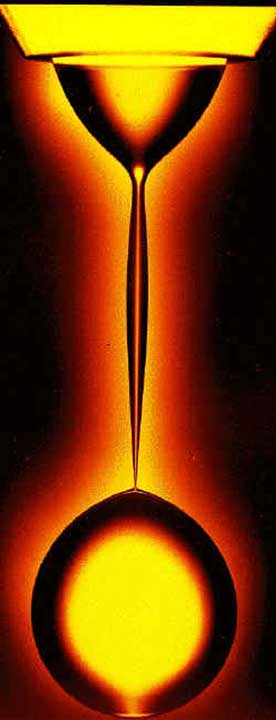Dripping Faucets

Physicist's lava lamp. Glycerin drips through a viscous oil, showing the details of pinching off in slow motion. Researchers have verified theories of the geometry at the point of snap-off (the narrowest point just above the spherical drop that has formed). Image credit: Phys. Rev. Lett. 83, 1147 (1999)
When the faucet drips, most people call the plumber or get out their tools, but some physicists are content to study the phenomenon instead. The equations describing the pinch-off of a drop of water are so difficult mathematically that they've only recently been solved. The problem is of interest in fields as disparate as black holes and ink jet printers. According to researchers, a drop's break-off point exhibits fractal properties--a slice through it looks the same at any time if you rescale the axes. The physicists confirmed that theoretical prediction with their own version of a dripping faucet where drops of one type of fluid drip through a different fluid.
Understanding the way fluid flows break into drops is useful for industry, in such areas as the mixing of chemicals and designing ink-jet printers, but the mathematics goes beyond these direct applications. At the moment of pinch-off, parts of the equations become infinite in a way that appears in other areas of physics, such as fluid turbulence, star formation, and the gravity around black holes. Researchers hope that studying this simple and controllable system will provide insights into these other problems as well.
Read more about this research at Physical Review Focus.
Text courtesy of Physical Review Focus.











